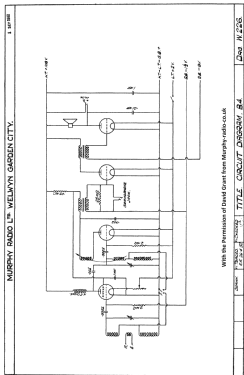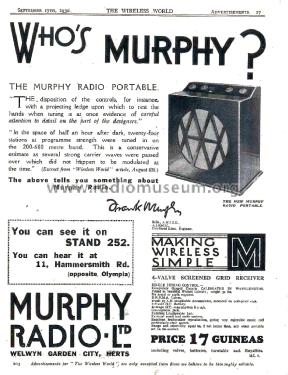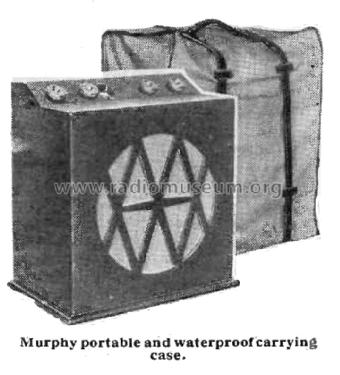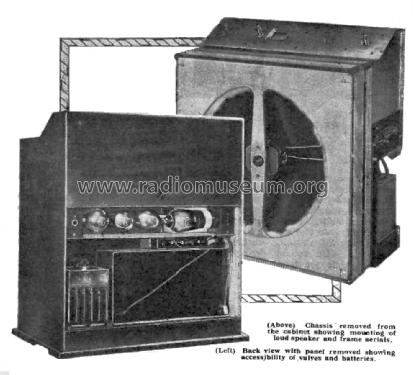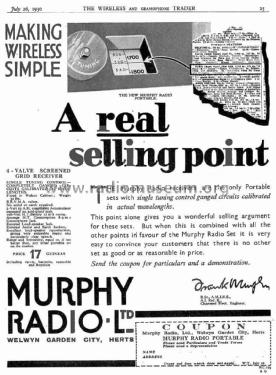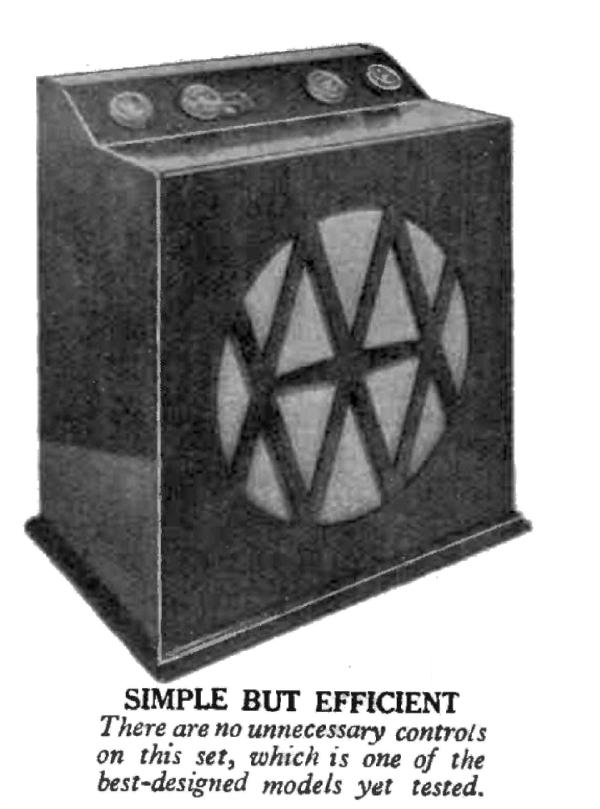4-Valve Screen Grid Portable B4 First cabinet design
Murphy Radio Ltd.; Welwyn Garden City
- Pays
- Royaume Uni
- Fabricant / Marque
- Murphy Radio Ltd.; Welwyn Garden City
- Année
- 1930
- Catégorie
- Radio - ou tuner d'après la guerre 1939-45
- Radiomuseum.org ID
- 336049
Cliquez sur la vignette du schéma pour le demander en tant que document gratuit.
- No. de tubes
- 4
- Principe général
- Récepteur TRF - par réaction (régénératif); Tube à grille écran 1926-1935.
- Gammes d'ondes
- PO uniquement
- Tension / type courant
- Piles (rechargeables ou/et sèches) / 2, 108 Volt
- Haut-parleur
- HP dynamique à aimant permanent + bobine mobile
- Matière
- Boitier en bois
- De Radiomuseum.org
- Modèle: 4-Valve Screen Grid Portable B4 First cabinet design - Murphy Radio Ltd.; Welwyn
- Forme
- Portative > 20 cm (sans nécessité secteur)
- Remarques
-
4-Valve Screen Grid Portable
- Single Tuning Control
- Completely Ganged Circuits Calibrated in Wavelengths
- Fitted in beautiful Walnut Cabinet
- No aerial or earth is required.
- B.R.V.M.A. Valves.
- 2 -volt, 23 AH Accumulator, mounted on an acid-proof rack.
- 108-volt HT Battery, 12 mA. rating. Average HT consumption, 8-9 mA.
- Gramophone Jack.
- External Loudspeaker Jack.
- External aerial and earth sockets.
The circuit comprises a single-screen grid stage of HF amplification, reacting leaky grid detector, and two transformer-coupled LF stages.
Excellent loudspeaker reproduction, giving very enjoyable music and particularly clear speech.
Range and selectivity are equal to, if not better than, any other portable set on the market.
The cabinet was redesigned in early 1932 with a new loudspeaker grille of bold and original design. No alterations were made to the chassis. See B4 second cabinet design.
- Poids net
- 32 lb (32 lb 0 oz) / 14.528 kg
- Prix de mise sur le marché
- 17.85 GB £
- Littérature
- Wireless World (The), London (WW, 79) (Wireless World Sep 17, 1930, Page 27.)
- Auteur
- Modèle crée par Gary Cowans. Voir les propositions de modification pour les contributeurs supplémentaires.
- D'autres Modèles
-
Vous pourrez trouver sous ce lien 367 modèles d'appareils, 301 avec des images et 234 avec des schémas.
Tous les appareils de Murphy Radio Ltd.; Welwyn Garden City
Contributions du forum pour ce modèle: Murphy Radio Ltd.;: 4-Valve Screen Grid Portable B4 First cabinet design
Discussions: 2 | Publications: 2
Murphy Portable Four - The selectivity of this portable exceeded our expectations"
Maker:- Murphy Radio, Ltd.
Price:- 17 guineas.
Power Supply:- Batteries. Easy access to the compartment at the back, which includes a 2-Volt accumulator and a standard-capacity 108-volt high-tension battery. The leads for these batteries are neat and durable.
Power Consumption:- A remarkably low total anode current consumption was measured, namely 8.5 milliamperes. The total low-tension current consumption was 0.5 ampere, so the accumulator supplied with the set will last at least 40 hours.
Valve Combination:- A high-frequency amplifier is followed by a detector and two stages of transformer-coupled low-frequency amplification. The first valve is a Mullard PM12 screen grid type, the detector a Mazda HL210, the first low frequency amplifying valve a Mazda HL210, and the power valve a Mullard PM2.
The makers. advance a very interesting argument in favor of four-valve combinations with only one screened-grid best high-frequency amplifier instead of two high-frequency amplifiers. They suggest that with one screened-grid high-frequency amplifier and two transformer-coupled low-frequency amplifiers the total gain might be 126,000, whereas the total gain of a two screened grid set on a similar basis might be 150,000 or very little more.
Type:- This four-valve portable is housed within an upright cabinet. It would rightly be termed transportable since its construction is obviously more suitable for a semi-permanent installation than for true portability.
Controls:- The makers have struck a new note in the arrangement of the controls. Four knobs are arranged in a line with the sloping control panel at the top of the cabinet. The maker's slogan "Making Wireless Simple” has been put into effect.
At the extreme left is a knob for wave changing. An aperture in the dial shows 200-600 " or " 800-2,000 according to its setting. Next is the tuning dial, which rotates a calibrated scale. The medium waves are calibrated in steps of 20 metres and the long wavelengths in steps of 100 metres. We found the set notable for the ease with which stations could be logged.
Next is the reaction knob. An aperture shows marks "0-9" so that the actual degree of reaction can be logged for distant stations. This marking should be of great help to non-technical users. Lastly, on the extreme right is the volume control and through an aperture in this dial can be read 1,2,3,4," so that even the degree of volume can be calibrated. Altogether we must say how very impressed we were with the controls of the Murphy portable. The makers have spared no pains to simplify the operation.
Sensitivity:- We were able to gain some idea of the abilities of this set during a recent evening when both long and medium-wavelength bands were explored. Starting on the long waves, we first logged Huizen at full loud-speaker strength using the maximum settings of the volume and reaction controls. Next came Radio Paris, a very good loudspeaker signal, provided that the volume control was set at its maximum. Then Zeesen, also good. Eiffel Tower did not need reaction, nor did Kalundborg whose stations came in at excellent strength. Lastly, Oslo was logged at fair strength without reaction. Switching over to the medium-wavelength band, we had no difficulty in logging seventeen stations at full loud-speaker strength. Budapest was fair, Vienna was good, Rome very good, as were Stockholm, Katowice, and Toulouse. Hamburg was good and Strasbourg was very good. Dresden. Bordeaux. Bratislava and Turin were all well heard between the two London Regional stations. Below the London National, we got Leipzig, Juan Les Pins, Nürnberg, and Cologne at excellent strength. There were many more stations available, but we logged only those that could be listened to with enjoyment.
Selectivity:- We must frankly confess that the selectivity of this Murphy portable exceeded our expectations London National at 261 had disappeared at 255 and 270 metres, a spread of only 15 metres. London Regional at 356 had gone again at 372 and 350, a spread of 22 metres. Other indications of good selectivity should be mentioned. Langenberg, for example, was received quite clear of the Midland Regional station. Due to the directional property of the frame aerial, we were able to get Hamburg clear of the London Regional. This same property enabled us to get Zeesen clear of Daventry on the long waves. When tuning in all the stations mentioned we noted how easy it was to rotate the cabinet in any desired direction due to the fitting of the smooth working turntable underneath.
Quality:- Considering how low is the anode-current consumption we judged the quality to be very satisfactory. The volume must not be increased beyond a certain well-defined limit owing to the natural limitation of the power valve working at 108 volts. The bass was not fully reproduced, but the tone generally was clear. We prefer this absence of deep bass to the most unnatural presence of artificial bass as produced by box resonance.

Appearance:- Extremely neat. The cabinet work belies the fact that this portable is only 17 guineas. It looks like an expensive set. The fittings are of good quality and the whole set is designed so that it will fit in with the average domestic requirements.
Summary:- For those without an electric-light supply and for those who find difficulty in erecting any sort of aerial wire, the battery-operated portable is the obvious solution. And the Murphy portable is an inexpensive way of fulfilling these requirements. It is one of the best-designed portables we have yet tested, irrespective of price
Wireless Magazine February 1931, page 48.
Gary Cowans, 18.Feb.22
Outstanding Range and Selectivity with a Single HF Stage.
A casual glance at the exterior of this receiver is sufficient to mark it as something a little out of the ordinary. The disposition of the controls for instance, with a projecting ledge upon which to rest the hands when tuning, is at once evidence of careful attention to detail on the part of the designers. No carrying handle is provided, as the makers feel that this would spoil the general appearance, but recesses for lifting are cut under the base of the cabinet at each side, and their position is such that the hands automatically fall under the centre of gravity of the set. A waterproof cover complete with a carrying handle and straps fitting under the base is being designed and will be sold as an extra so that the set could be equally well described as a " Portable," "Transportable " or " Table Model." On second thoughts one might be inclined to delete the term " Transportable," as this generally suggests weight, actually, the Murphy portable weighs only 32 pounds, which is less than many so-called " portables."
The Circuit.
The circuit, which comprises a single-screen grid stage of H.F. amplification, reacting leaky grid detector, and two transformer-coupled LF stages, does not contain any strikingly unconventional feature, but rather more than the usual care has been taken to extract the last ounce of efficiency from each. component. Through the courtesy of the directors, we were afforded the opportunity of seeing the sets in course of construction, and of inspecting the apparatus for checking the electrical constants of HF circuits before assembly. Every factor from the frame aerial circuit through the always troublesome detector stage to the output from the power valve has been the subject of exact measurement, and where compromise has been found necessary this has been made on the foundation of concrete fact.
The HF stage is coupled by the parallel choke feed method, the tuned anode circuit being connected between the grid and filament of the detector valve. The frame aerial and anode circuit condensers are ganged, and the HF properties of both circuits are so adjusted that the amplification over both long and shortwave ranges are practically constant. Every precaution has been taken to exclude all couplings between the circuits other than the residual capacity of the valve, which is taken into account when setting the ganging of the two circuits.
The screening material, used in the chassis is tinned iron, and additional precautions to prevent stray coupling include insulation of the tuning condenser spindles, screening between the contacts of the wave range switch, the elimination of common earth wiring, and decoupling of the bias to the screen grid valve. These precautions have borne fruit in another direction in that threshold howl, which is frequent trouble in portables, particularly on the longwave range, has also been eliminated. Unless great care is taken with the detector stage all the precautions made with a view to accurate ganging of the HF circuits are nullified. The working grid filament capacity of the detector, which is in parallel with the tuned anode circuit, must be kept within well-defined limits and of as small a value as possible. To this end, a fixed by-pass condenser and reaction coil of small inductance is used, and control of the reaction is obtained by rotating the reaction coil. The loading effect of grid current has been allowed in designing the tuned grid circuit. Positive bias for the detector valve is derived from a fixed potentiometer across the filament circuit, and the anode voltage is reduced to the required value through a decoupling resistance and condenser.
The valves used in the first and second LF stages are Osram HL-210 and P-215 respectively, and the characteristics of the coupling transformers have been adjusted to compensate for deficiencies in the loudspeaker response. A modulated source of HF is used in conjunction with a completely assembled set in making this compromise so that all factors such as sideband cutting, and box resonance are included in the final result. In this way, the objectionable resonance in the vicinity of 150-200 cycles so common in portable sets has been eradicated, and speech is free from unpleasant " boom." The middle and upper registers are well represented, and the general impression is one of crispness and clarity.
The Controls
Mention has already been made of the convenient disposition of the controls. The wave range switch in the extreme left is smooth in operation and does not produce any sound in the loudspeaker when changing over with the set in operation. Next to it is the main tuning knob for the slow-motion ganged condensers. The condenser scale is calibrated in wavelengths and is viewed through a small window carrying a horizontal hairline.
Broadcast Receivers Reviewed
The reaction control is smooth and free from backlash or threshold howl. On the extreme right is the combined on-off switch and volume control. This consists of a switch for the detector and LF valves and a filament resistance in the positive filament lead of the HF valve.
The performance of the set both as regards range and selectivity fully justifies the care taken in designing the HF circuits. On longwave, there is a commendable absence of mush, and the range is distinctly above the average. No difficulty was experienced in tuning in ten stations where only, six or at the most seven are usually available, and Konigswusterhausen could be received at unusually good strength clear of 5XX and Radio Paris without making full use of the directional properties of the frame (a ball-bearing turntable is a standard item of the equipment).
In the space of half an hour after dark, twenty-four stations at program strength were tuned in on the 200-600 metre band. This is a conservative estimate as several strong carrier waves were passed over which did not happen to be modulated at the time.
At five miles. from Brookmans Park there is not the least difficulty in separating the twin transmitters, while in North-West London at a distance of 10 miles, London National (261 metres) can be limited to a band 7 metres wide, and London Regional (356 metres) to a band 20 metres in width. To obtain these figures the frame aerial must, of course, be set at a minimum, but the performance is exceptionally good for a single HF stage and only two tuned circuits. As further proof of the range, it may be mentioned that Langenburg (473 metres) could be received consistently in daylight.
The photograph of the back of the set shows that the valves are readily accessible, and that economical use has been made of the space allocated to batteries. The HT battery has only two sockets, which greatly simplifies replacement, and the internal resistance would have to rise to 5,000 ohms to produce motor boating-a value unlikely to be reached in practice. The battery is rated for 12 mA. discharge, so that the normal anode current of 8 to 9 mA. is well within its capacity. The measured total HT current of the receiver tested was 8.0 mA. Further evidence of careful attention to detail is provided by the mounting of the LT battery. This is insulated from the woodwork by moulded ebonite guides and a paxolin sheet which is removable for cleaning so that the possibility of acid creeping along the bottom of the cabinet is considerably reduced.
During the course tests, more than 80 miles were covered in a not-too-comfortable car without any detriment to valves or wiring.
To the student of portable set design, this receiver should prove of special interest, as it demonstrates conclusively that a single HF stage coupled with reaction in the detector can be made, by careful design, to give more than adequate range and selectivity without the mush and background noise which is frequently associated with two HF stages.
The price of this receiver complete with valves and turntable but without a waterproof carrier is £17 17s., and the makers are Murphy Radio, Ltd., Broadwater Road, Welwyn Garden City, Herts.
Wireless World September 6, 1930, Pages 127,128.
Gary Cowans, 18.Feb.22
